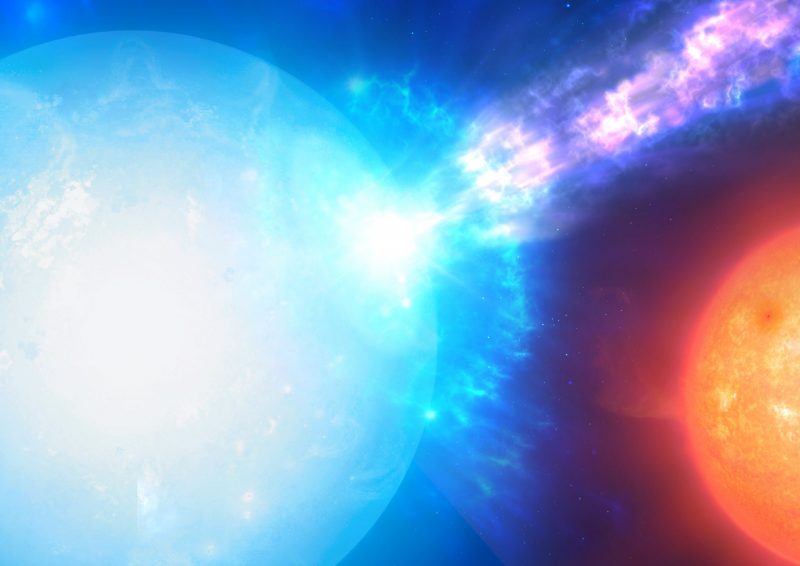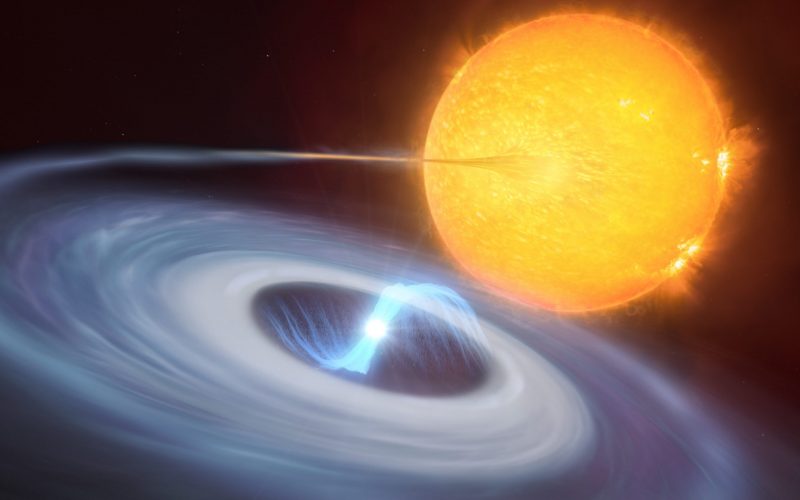The European Southern Observatory (ESO) said on April 20, 2022, that its astronomers have confirmed a new type of exploding star, which they’re calling a micronova. As in an ordinary nova, it happens when a white dwarf star feeds off a companion star. White dwarfs are dead stars, with masses comparable to our sun, but compressed to the size of the Earth. When they go nova, they increase in brightness suddenly, and return to their former brightness only months or years later. Micronovas, on the other hand, last just hours. And they have only about a millionth the strength of an ordinary nova.
Yet a micronova is a vast explosion. It could incinerate as much material as about 3.5 billion Great Pyramids of Giza within its few hours of activity.
And here’s another difference. In an ordinary nova, the brightness increases across the entire surface of a white dwarf. In a micronova, infalling material pulled from a companion star produces a localized explosion, contained near one of the white dwarf’s poles.
These astronomers said micronovas might be common in our Milky Way galaxy. But they’re short-lived and so tough to catch in action.
The peer-reviewed journal Nature published these results on April 22. Another journal, Monthly Notices of the Royal Astronomical Society, has also accepted a companion paper for publication, but it is not yet peer-reviewed.
Discovery of a micronova
The team first came across micronovas analyzing data from NASA’s Transiting Exoplanet Survey Satellite (TESS). Astronomer Simone Scaringi at Durham University, one of the team members, said:
Looking through astronomical data collected by NASA’s TESS, we discovered something unusual: a bright flash of optical light lasting for a few hours. Searching further, we found several similar signals.
The team observed three micronovas with TESS. Two were already known as white dwarfs. They used the Very Large Telescope in Chile to confirm the third star’s white dwarf status. Scaringi commented:
We have discovered and identified for the first time what we are calling a micronova. The phenomenon challenges our understanding of how thermonuclear explosions in stars occur. We thought we knew this. But this discovery proposes a totally new way to achieve [stellar explosions].
What makes a micronova?
Microvnoas form in a similar way to novas. Both begin when a white dwarf accumulates material pulled from a nearby companion star. In a nova, the infalling gas reaches the white dwarf’s hot surface and triggers hydrogen atoms to fuse into helium. This releases energy with a bang. In the case of novas, these explosions involve the star’s entire surface. And, as team member Nathalie Degenaar of the University of Amsterdam said:
Such detonations make the entire surface of the white dwarf burn and shine brightly for several weeks.
On the other hand, micronovas don’t involve the entire surface of the star. They happen only at the white dwarf’s poles, where the white dwarf’s magnetic fields are funneling in the new material stolen from the companion star. Micronovas last only a few hours. Team member Paul Groot of Radboud University in the Netherlands said:
For the first time, we have now seen that hydrogen fusion can also happen in a localized way. The hydrogen fuel can be contained at the base of the magnetic poles of some white dwarfs, so that fusion only happens at these magnetic poles. This leads to micro-fusion bombs going off, which have about one-millionth of the strength of a nova explosion. Hence the name micronova.

How common are micronovas?
Astronomers studied three micronovas in data from TESS. Degenaar described their discovery:
Looking through astronomical data collected by NASA’s TESS, we discovered something unusual: a bright flash of optical light lasting for a few hours. Searching further, we found several similar signals.
They used the VLT for follow-up on one of the events. While these may be the first micronovas scientists have seen, that’s probably because they are dimmer and quicker, making them more difficult to capture. Scaringi said:
It just goes to show how dynamic the universe is. These events may actually be quite common, but because they are so fast they are difficult to catch in action.

Bottom line: A new type of stellar explosion – a micronova – occurs when a white dwarf steals material from a companion star resulting in a contained explosion at one of the white dwarf’s poles.
Source: Localized thermonuclear bursts from accreting magnetic white dwarfs
The post Micronovas are new! They’re small, but mighty first appeared on EarthSky.
0 Commentaires